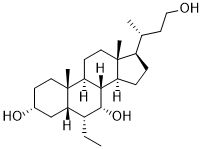BAR-502
This product is for research use only, not for human use. We do not sell to patients.

For small sizes, please check our retail website as below: www.invivochem.com
| Size | Price | Stock |
|---|---|---|
| 250mg | $1450 | Check With Us |
| 500mg | $2100 | Check With Us |
| 1g | $3150 | Check With Us |
Cat #: V12283 CAS #: 1612191-86-2 Purity ≥ 98%
Description: BAR502 is a dual FXR and GPBAR1 agonist.
Top Publications Citing Invivochem Products
Publications Citing InvivoChem Products
Product Promise

- Physicochemical and Storage Information
- Protocol
- Related Biological Data
- Stock Solution Preparation
- Quality Control Documentation
| Molecular Weight (MW) | 392.62 |
|---|---|
| Molecular Formula | C25H44O3 |
| CAS No. | 1612191-86-2 |
| SMILES Code | O[C@@H]1CC[C@]2(C)[C@@]3([H])CC[C@]4(C)[C@@H]([C@@H](CCO)C)CC[C@@]4([H])[C@]3([H])[C@H](O)[C@H](CC)[C@]2([H])C1 |
| Synonyms | BAR-502; BAR 502; BAR502 |
| Protocol | In Vitro | BAR502 is a truncated side chain alcohol with both substituents on ring B in α-configuration. At the concentration of 10 μM, BAR502 fails to transactivate GR, PPARγ, and LXR, respectively, but it transactivates the nuclear receptor PXR. BAR502 is able to induce the expression of pro-glucagon mRNA in GLUTAg cells, an intestinal endocrine cell line, as well as to increase cAMP concentrations in THP-1 cells. BAR502 induces the expression of OSTα, BSEP, and SHP in HepG2 cells. BAR502 shows a very potent activity in the recruitment of SRC-1 coactivator and high affinity to FXR. |
|---|---|---|
| In Vivo | Treatment with BAR502 causes a 10% reduction of b.w., increases insulin sensitivity and circulating levels of HDL, while reduces steatosis, inflammatory and fibrosis scores and liver expression of SREPB1c, FAS, PPARγ, CD36 and CYP7A1 mRNA. BAR502 increases the expression of SHP and ABCG5 in the liver and SHP, FGF15 and GLP1 in intestine. BAR502 promotes the browning of epWAT and reduces liver fibrosis induced by CCl4. |
These protocols are for reference only. InvivoChem does not
independently validate these methods.
| Solvent volume to be added | Mass (the weight of a compound) | |||
|---|---|---|---|---|
| Mother liquor concentration | 1mg | 5mg | 10mg | 20mg |
| 1mM | 2.5470 mL | 12.7350 mL | 25.4699 mL | 50.9398 mL |
| 5mM | 0.5094 mL | 2.5470 mL | 5.0940 mL | 10.1880 mL |
| 10mM | 0.2547 mL | 1.2735 mL | 2.5470 mL | 5.0940 mL |
| 20mM | 0.1273 mL | 0.6367 mL | 1.2735 mL | 2.5470 mL |
The molarity calculator equation
Mass(g) = Concentration(mol/L) × Volume(L) × Molecular Weight(g/mol)
Mass
=
Concentration
×
Volume
×
Molecular Weight*
The dilution calculator equation
Concentration(start)
×
Volume(start)
=
Concentration(final)
×
Volume(final)
This equation is commonly abbreviated as: C1 V1 = C2 V2
Concentration(start)
C1
×
Volume(start)
V1
=
Concentration(final)
C2
×
Volume(final)
V2
Step One: Enter information below
Dosage mg/kg
Average weight of animals g
Dosing volume per animal µL
Number of animals
Step Two: Enter the in vivo formulation
%DMSO
+
%
+
%Tween 80
+
%ddH2O
Calculation Results:
Working concentration:
mg/ml;
Method for preparing DMSO master liquid:
mg
drug pre-dissolved in
µL
DMSO(Master liquid concentration
mg/mL)
,Please contact us first if the concentration exceeds the DMSO solubility of the batch of drug.
Method for preparing in vivo formulation:
Take
µL
DMSO master liquid, next add
µL
PEG300, mix and clarify, next add
µL
Tween 80,mix and clarify, next add
µL
ddH2O,mix and clarify.
Note:
- (1) Please be sure that the solution is clear before the addition of next solvent. Dissolution methods like vortex, ultrasound or warming and heat may be used to aid dissolving.
- (2) Be sure to add the solvent(s) in order.




































